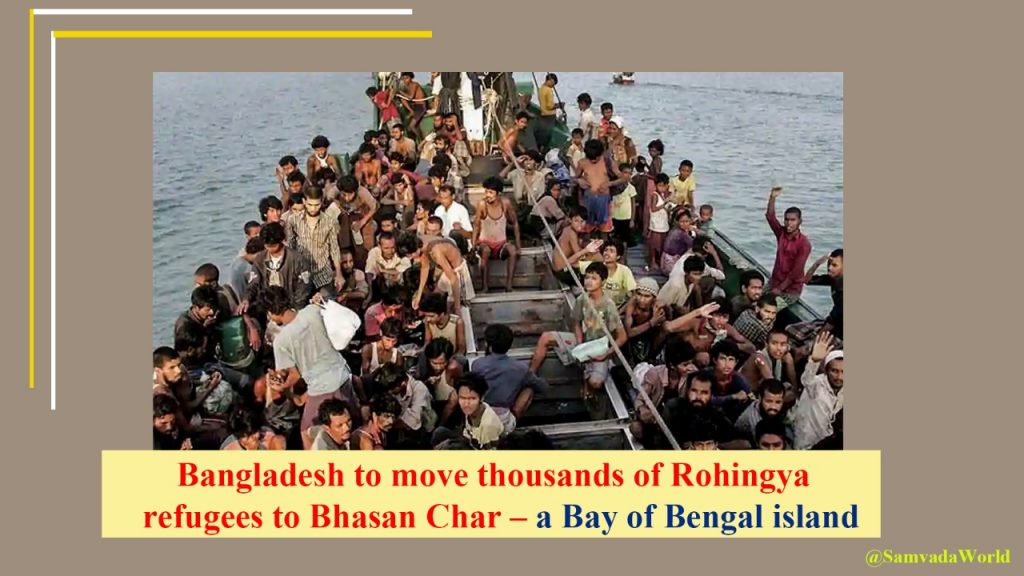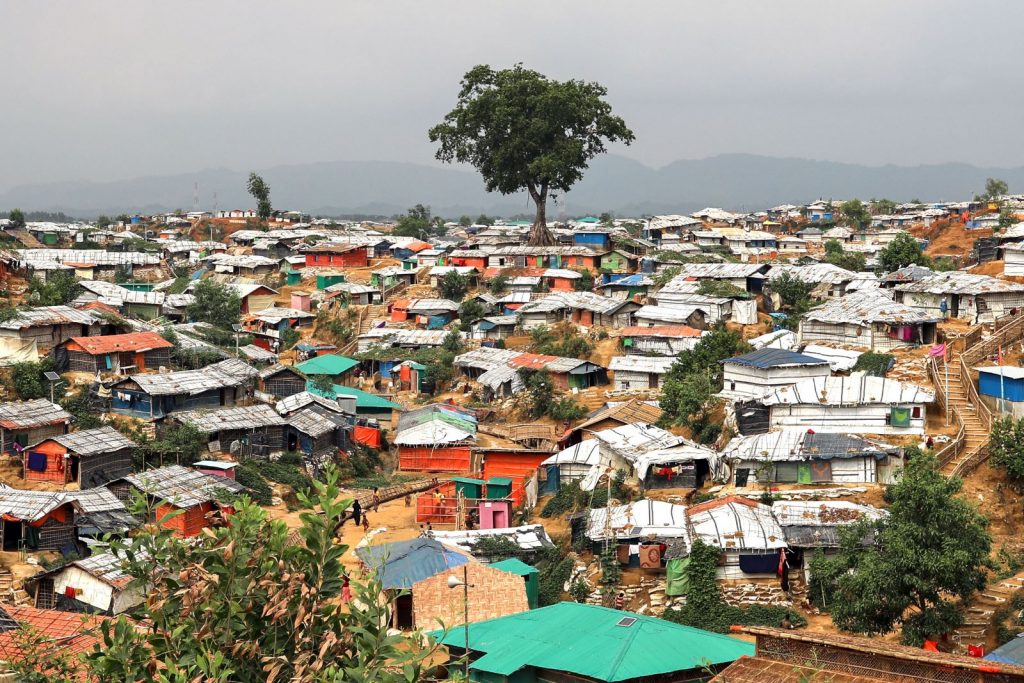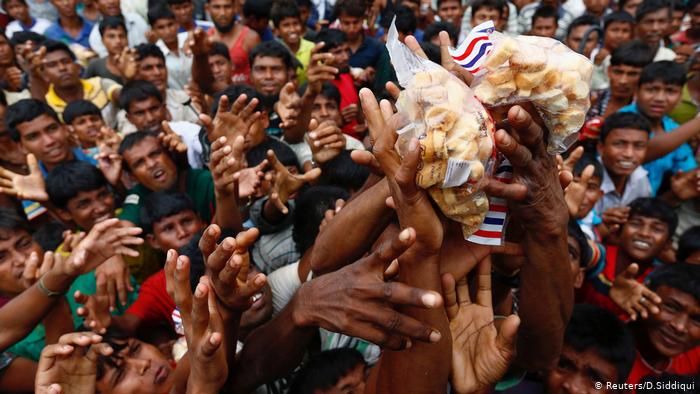Summary: Bangladesh begins to relocate hundreds of Rohingya refugees to the island of Bhashan Char starting Thursday. UN and rights groups have objected to the move claiming that the island is low-lying and dangerous and is prone to cyclones and floods. The island of Bhashan Char covers an area of about 52 square kilometres. The Bangladesh Navy has built shelters there for at least 100,000 Rohingya refugees as well as a nine-foot (three-metre) embankment to prevent flooding.
Bangladesh says that overcrowding from the recent population boom at Bangladesh’s Rohingya refugee camps has placed a strain on its infrastructure. The refugees lack access to services, education, food, clean water, and proper sanitation; they are also vulnerable to natural disasters and infectious disease transmission. Bangladesh, which is one of the poorest countries in the world says that it cannot provide facilities for the refugees when its own citizens are in distress in many parts of the country.
Countries like Bangladesh where the Rohingyas are sheltered are facing grave economic, social and environmental challenges due to the Rohingya crisis. The Bangladesh government on its own or Myanmar alone cannot handle this problem. The global community and organizations must come forward to help Bangladesh and Myanmar in resolving this crisis.
As Bangladesh begins to relocate hundreds of Rohingya refugees to the island of Bhashan Char starting Thursday, the UN and rights groups have objected to the move claiming that the island is low-lying and dangerous and is prone to cyclones and floods. Bangladesh says that these are a handful of nearly million Rohingyas who are being relocated on a pilot basis after taking their due consent.
Estimates suggest that nearly 1.1 million Rohingya Muslims live in camps across Bangladesh, especially its south-eastern region, for several years. The Rohingyas claim that they fled the Myanmar military offensive in 2017 while many in Myanmar say that many have left on their own for better opportunities and living conditions. As a matter of fact, the Rohingyas from Myanmar have been coming into Bangladesh and neighbouring countries like India Since the 1970s . In the 1990s, more than 250,000 resided in refugees camps in Bangladesh. In the early 2000s, all but 20,000 of them were repatriated to Myanmar while some had to be forced to leave.
The present crisis between the Rohingya Muslims and the Myanmar Buddhists has only increased the inflow but is not the only reason making them to leave Myanmar. The Bangladesh government wants them to return to Myanmar but the refugees say that they cannot go without assurance from the Myanmar government. The Bangladesh government which says that it cannot feed more refugees had proposed the relocation plan to the UN and neighbouring countries. It was under this plan that Bangladesh undertook the pilot project of relocating a few hundred refugees to the island.
The island of Bhashan Char covers an area of about 52 square kilometres. The Bangladesh Navy has built shelters there for at least 100,000 Rohingya refugees as well as a nine-foot (three-metre) embankment to prevent flooding.
The refugees were taken in buses from their camps in the Cox’s Bazar region to the port city of Chittagong. From Chittagong the refugees will be taken by military landing craft to the island of Bhashan Char on Friday. While Bangladesh says it will only be a few hundreds in the first phase, international agencies say that thousands are being relocated. The UN which is not amused, in a statement said that it was “not involved” in the relocation process and had been given “limited information”.

Is this the first attempt at relocation?
The relocation plan was first proposed by the Bangladesh government in 2015 much before the so-called military offensive in Myanmar. The original proposal too aimed at relocating the Rohingya refugees in Bangladesh to the island of Bhasan Char in the Bay of Bengal. However, the proposal was rejected by the UNHCR and Human Rights activists the same year. Neither the UN nor the HR activists proposed an alternative plan and they had also failed to convince the Myanmar government of their safety and well-being.
In 2017, Bangladesh initiated talks with the Myanmar government and signed an MOU in November. Under the deal, both nations were to establish the final terms for the beginning of the process within three weeks. Myanmar would ensure that they are not kept in the camps for long and are issued identity cards. The plan did not fructify as Myanmar did not provide a concrete repatriation plan that was acceptable to the UN and the process of identification.
In January 2018, Bangladesh’s foreign ministry announced that their government and Myanmar’s had bilaterally agreed on a repatriation deal for Rohingya refugees in Bangladesh, which would aim to complete the process of repatriation within two years. The government of Myanmar agreed to repatriate only 374 Rohingya refugees out of a list of over 8,000 submitted by their Bangladeshi counterparts on 14 March 2018, citing incomplete paperwork as the reason for the slow process. But on 18 May 2018, they announced they would repatriate a total of 1,100 “verified” Rohingyas from the list.
The influx of Rohingyas into Bangladesh and other neighbouring countries is putting a strain on their resources. In Bangladesh, public health officials have identified that the refugees suffer from several health issues due to living in squalid camps for many years. Many of them were identified with mental health issues, food- and water-borne diseases, infectious diseases, malnutrition among others. However, the economy of Bangladesh can neither provide them with the required standard of living nor can it ensure proper livelihoods for them.

Impact of the Rohingyas on Bangladesh
Bangladesh says that overcrowding from the recent population boom at Bangladesh’s Rohingya refugee camps has placed a strain on its infrastructure. The refugees lack access to services, education, food, clean water, and proper sanitation; they are also vulnerable to natural disasters and infectious disease transmission. Bangladesh, which is one of the poorest countries in the world says that it cannot provide facilities for the refugees when its own citizens are in distress in many parts of the country.
In June 2018 the World Bank announced nearly half a billion dollars in monetary support to help Bangladesh address Rohingya refugees. The monetary support was to be used in the areas including health, education, water and sanitation, disaster risk management, and social protection. Bangladesh which was accepting the Rohingyas till the beginning of 2019, in March said that it would no longer accept Rohingya refugees due to a myriad of reasons.
A research paper on the impact and challenges to Bangladesh due to sheltering the Rohingya refugees, found that Bangladesh was facing and will face grave economic, social and environmental challenges due to the Rohingya crisis.
The paper found that the Local economy and its employment structures can easily be changed due to the Rohingya crisis. As jobs are readily available at the UN monitored refugee camps, unemployed local youth and the day labourers are switching to work in the camps with the aid agencies. This job opportunity has created a shortage of labor in the local market, and finding workers has been a problem for the local farmers. The other area of impact is tourism. The ongoing instability along the Bangladesh-Myanmar border has resulted in a low tourist turnout and Bangladesh is at risk of losing more than a million tourists.
Several NGO workers have noted that the Rohingyas have little awareness of family planning, and the population of Rohingya is likely to increase in the camps. In the near future, it will put additional pressure on food, jobs, health, and other basic needs.
Apart from the health concerns, education of Children and their livelihood needs, the refugees are also a psychological strain on the local residents due to multi-dimensional problems. The research paper found that the local people who could move freely in their neighborhood, now have to carry their national identity card with themselves to prove they are Bangladeshi nationals. Most of them used to graze their cattle in the fields, which are now occupied by the Rohingya Muslims. The local people often feel insecure and do not know what they would do if the Rohingya refugees become violent. The Rohingya refugees often try to enter local villages.
The influx of Rohingyas has also resulted in increase in Human Trafficking, prostitution, fake identity, drug cartels and misuse of Bangladeshi SIM cards.

The environmental impact includes deforestation in the camp area, improper waste disposal, groundwater depletion, risk of landslides and adverse impact on wildlife. The initial loss of forest area is 3,500 acres from the total forest area of 2,092,016 acres due to Rohingya concentration in Cox’s Bazar. Another estimate suggests that as the Rohingya refugees also collect fuelwood for their cooking from the forest areas within the 10 kilometers zone around the Rohingya camps forest land of 26,000 hectares will be ruined with low biomass and productivity.
Wildlife and wilderness are at stake because of the makeshift camps as per the UNEP report. It has a significant impact on wildlife, particularly on the elephants suffering from habitat loss and fragmentation.
In conclusion, the efforts of Bangladesh to repatriate the Rohingyas should be supported by all concerned nations, especially the neighbouring countries. Unless the Rohingya crisis is resolved, all the countries will continue to suffer which will strain their resources and also bring in demographic changes, adverse impact on socio-economic stability and consequent problems.
An in-depth study should be undertaken by the concerned government to evaluate the short-term, medium-term, and the long-term implications for national or domestic and foreign resources. The Asian governments should also estimate all relevant costs (i.e., explicit costs, implicit costs) related to the Rohingya crisis.
The Bangladesh government on its own or Myanmar alone cannot handle this problem. The global community and organizations must come forward to help Bangladesh and Myanmar in resolving this crisis. While it is necessary to restore the rights of the Rohingya, the impact on the countries where they reside should also not be neglected. Finally, Myanmar must be impressed upon to resolve the crisis in its Rakhine state and support it with necessary infrastructure and funds to ensure that it rehabilitates the Rohingya people in their own country.
